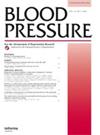CPAP对阻塞性睡眠呼吸暂停合并夜间高血压患者动态降压效果的随机对照研究
IF 2.3
4区 医学
Q2 PERIPHERAL VASCULAR DISEASE
引用次数: 8
摘要
摘要目的:在一项随机对照试验中,我们研究了持续气道正压通气(CPAP)对中重度阻塞性睡眠呼吸暂停综合征(OSAS,呼吸暂停-低通气指数,AHI为15或更高)和夜间高血压(夜间收缩压/舒张压≥120/70 mmHg)患者的血压(BP)降低效果。方法:60例患者在维持降压治疗的同时,随机分为CPAP组和假CPAP组。在基线(首次就诊)和随访结束时进行动态血压监测。在基线和每个月的随访中测量门诊和家庭血压。结果:60例患者中,47例完成了为期3个月的研究。与假CPAP (n = 21)相比,CPAP (n = 26)使24小时收缩压/舒张压略微和非显著降低- 2.8/ - 2.5 mmHg (p≥0.27),白天组间差异(- 4.0/ - 2.8 mmHg, p≥0.29)略大于夜间组间差异(- 0.2/ - 1.5 mmHg, p≥0.50)。随访期间,CPAP治疗对临床或家庭血压无显著影响(p≥0.27)。然而,简单和偏相关分析显示,动态降压效果依赖于基线时的日间脉搏率(r≥0.47,p≤0.01)。在日间脉搏率大于85次/分钟的患者中,CPAP组(n = 10)的日间收缩压平均变化显著大于假CPAP组(n = 11),组间平均差异为- 10.1 mmHg (p = 0.048)。结论:CPAP治疗对中重度OSAS合并夜间高血压患者无明显的动态降压效果。然而,对于脉搏加快的患者,它可能对降低白天血压有效。本文章由计算机程序翻译,如有差异,请以英文原文为准。
A randomized controlled trial on ambulatory blood pressure lowering effect of CPAP in patients with obstructive sleep apnea and nocturnal hypertension
Abstract Objective: In a randomised controlled trial, we investigated the blood pressure (BP) lowering effect of continuous positive airway pressure (CPAP) in patients with moderate-severe obstructive sleep apnoea syndrome (OSAS, an apnoea-hypopnoea index, AHI of 15 or higher) and nocturnal hypertension (night-time systolic/diastolic BP ≥120/70 mmHg). Methods: Sixty patients were randomly assigned to CPAP or sham CPAP, while maintaining their antihypertensive treatment. Ambulatory BP monitoring was performed at baseline (first run-in visit) and the end of follow-up. Clinic and home BP were measured at baseline and each of the monthly follow-up visits. Results: Of the 60 patients, 47 completed the 3-month study. CPAP (n = 26), compared with sham CPAP (n = 21), slightly and non-significantly reduced 24-h systolic/diastolic BP by −2.8/−2.5 mmHg (p ≥ 0.27), with a slightly greater between-group difference in the daytime (−4.0/−2.8 mmHg, p ≥ 0.29) than night-time (−0.2/−1.5 mmHg, p ≥ 0.50). The CPAP treatment did not significantly influence clinic or home BP during follow-up (p ≥ 0.27). Nonetheless, simple and partial correlation analyses showed that the ambulatory BP lowering effect was dependent on the daytime pulse rate at baseline (r ≥ 0.47, p ≤ 0.01). In patients with a daytime pulse rate greater than 85 beats/min, the mean changes in daytime systolic BP were significantly greater in the CPAP (n = 10) than sham CPAP group (n = 11), with a between-group mean difference of −10.1 mmHg (p = 0.048). Conclusions: The CPAP treatment did not show significant ambulatory BP lowering effect in patients with moderate-severe OSAS and nocturnal hypertension. However, it may be effective in lowering daytime BP in patients with a faster pulse rate.
求助全文
通过发布文献求助,成功后即可免费获取论文全文。
去求助
来源期刊

Blood Pressure
医学-外周血管病
CiteScore
3.00
自引率
5.60%
发文量
41
审稿时长
6-12 weeks
期刊介绍:
For outstanding coverage of the latest advances in hypertension research, turn to Blood Pressure, a primary source for authoritative and timely information on all aspects of hypertension research and management.
Features include:
• Physiology and pathophysiology of blood pressure regulation
• Primary and secondary hypertension
• Cerebrovascular and cardiovascular complications of hypertension
• Detection, treatment and follow-up of hypertension
• Non pharmacological and pharmacological management
• Large outcome trials in hypertension.
 求助内容:
求助内容: 应助结果提醒方式:
应助结果提醒方式:


